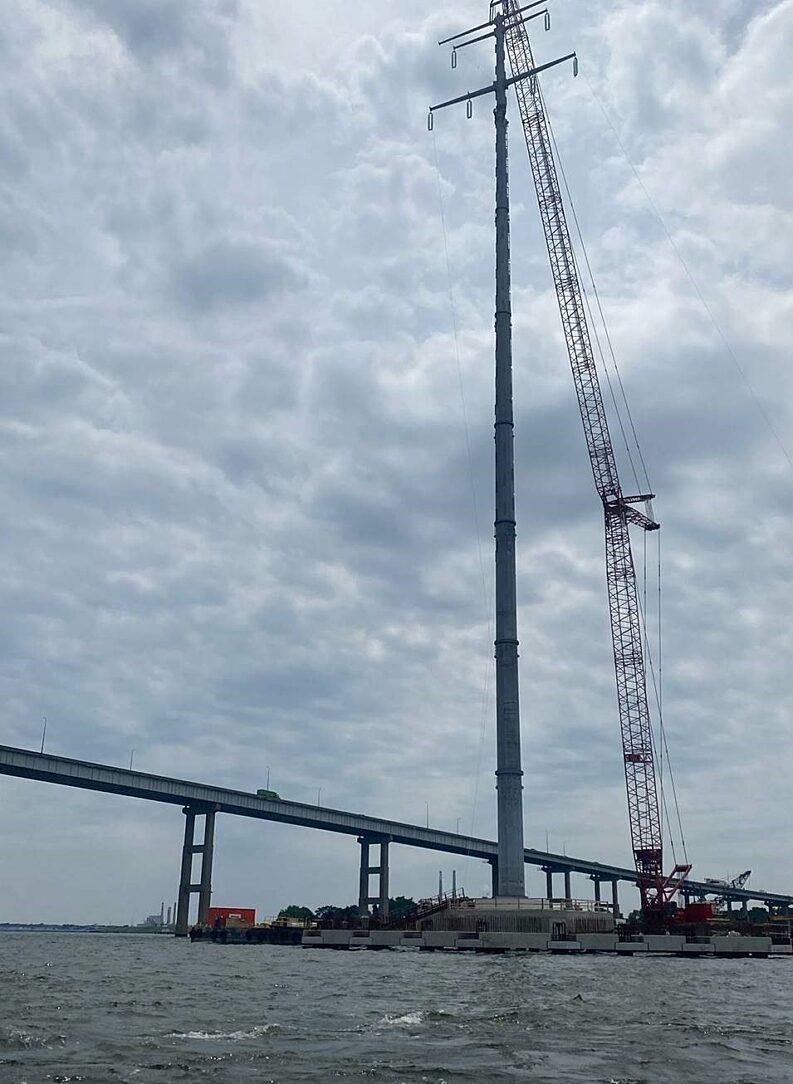BALTIMORE, MD UNITED STATES 2022
Valmont Coatings - Salina Galvanizing
In addition to providing the necessary corrosion protection, hot-dip galvanizing also delivered on the other key project goals: environmental sensitivity and economic impact.
Baltimore Gas and Electric (BGE) continuously monitors its systems and equipment to provide safe and reliable electric and gas service to its customers throughout central Maryland. As infrastructure ages, BGE repairs or replaces impacted equipment or system components to maintain system reliability. BGE’s Key Crossing Reliability Initiative is a project to replace two high voltage transmission circuits that extend beneath the Patapsco River due to the existing line nearing the end of its useful service life.
The project started in 2013, with an evaluation of the various replacement options. The initial study reviewed the use of a variety of technology solutions including using new high-pressure fluid-filled cables, attaching cables to the bridge, jet plowing submarine cables, horizontal directional drilling, and construction of a dedicated tunnel. The study originally reviewed underground construction methods, but the magnitude of the probable environmental impacts associated with these methods led to the initiation of an overhead transmission replacement study. The study determined two viable options: jet plowing submarine cables or constructing an overhead transmission line. After discussions with regulatory agencies, BGE selected the overhead project as the preferred option due to environmental sensitivity, cost savings, economic impacts, and workforce development.
The overhead replacement option was still a complex project. To cross the nearly 2 ½ mile Patapsco River, five out of the eight new transmission towers were installed in the river with collision-protection structures. This includes what is now the tallest transmission monopole on the continent! The remaining three towers are located landside to complete the overall connection. A range of cranes, barges, and heavy equipment were required to construct the towers over the water and a helicopter was used to delicately string new electrical conductor and static lines from shoreline to shoreline.
The steel monopole solution created for the Key Crossing Reliability Initiative delivered on the overall project goals through every aspect of the design including corrosion protection. The system’s proximity to the ocean’s saltwater and urban pollution from Baltimore’s traffic and industrial region already creates a corrosive environment. Add in the temperate marine climate with hot, humid summers and cold, windy winters and corrosion protection becomes critical to the safety and longevity of steel structures. That is why hot-dip galvanizing per ASTM A123 was specified for this project.
Hot-dip galvanizing performs very well in corrosive environments, including temperate marine climates. In addition to providing the necessary corrosion protection, galvanizing also delivered on the other key project goals: environmental sensitivity and economic impact. The primary component of hot-dip galvanizing is zinc, a natural and abundant resource already found in the Earth’s soil and waterways. HDG steel is safe for the environment and won’t introduce foreign substances to the surrounding area. It is also 100% recyclable meaning that at the end of its service life, the transmission poles can be recycled and put right back into use. On the economic side, hot-dip galvanized steel requires very little, if any, maintenance over its expected life. In addition to the cost routine maintenance adds to the project, it would be extremely difficult to perform above the Patapsco River. The protective coating will also extend the life of the transmission towers, meaning another replacement project won’t happen again for several decades.
The tall and slender geometry of the poles posed challenges for the project team. They were delivered in multiple sections because they were so long. All the poles themselves could have their own story. The A-sections specifically posed issues because they were too large for any hot-dip galvanizing kettle in the United States. For these items, the poles sections were progressively dipped before welding to the remaining part. This required grinding off a portion of the galvanized finish and utilizing metallizing to achieve corrosion protection on the section that could not be hot-dip galvanized.
Test fitting was also very important for these tall structures. The customer did not want them to have a bend and a contributing factor to this is interfacing. Since hot-dip galvanizing can build up on one side of a structure, BGE put a lot of time into measuring each individual component throughout the process.
The Key Crossing Reliability project helps BGE continue to deliver on their 200-year commitment of reliable service as the nation’s first gas utility. With over 1.2 million residential and business customers spanning over 2,300 square miles, BGE plays an important role in the everyday lives of Baltimore region residents. With a new, innovative transmission line crossing the Patapsco River, the region can expect reliable electrical service well into the future.
This project was powered by a CIC Pittsburgh Galvanizing furnace.
